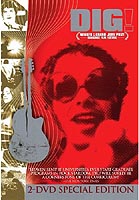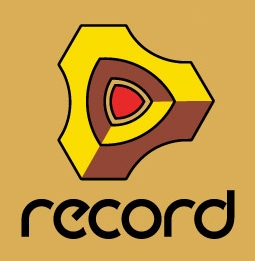
DIG! DVD Cover
Review: “DIG!” (2004) Winner of the Grand Jury Price – Sundance Film Festival
Rating: 5/5 Stars
“DIG!” is a seven year film project by Ondi Timoner covering two extremely talented bands, The Dandy Warhols and Brian Jonestown Massacre, which came from similar surroundings, but the former found moderate success while the latter struggles relentlessly.
The Bands
The Dandy Warhols (“Not If You Were the Last Junkie on Earth,” “Bohemian Like You,” “You Were the Last High (with producer Nick Rhodes from Duran Duran)”) managed to cooperate together as a cohesive whole throughout the years, only losing their original drummer due to personal reasons. While never finding a major fan base stateside, they succeeded in breaking into the European market.
The Brian Jonestown Massacre (BJM) (“When Jokers Attack,” “That Girl Suicide,” “Nothing to Lose”), however, has had a very rocky and volatile past. The founder – and control-freak – Anton Newcombe, is a major self-saboteur, with drugs, alcohol, violence, and a hatred of the recording industry being obstacles to his success. The band line-up changed frequently due to his antics.
But this is not to say BJM isn’t without talent. Despite all of his demons, Newcombe is a phenomenal songwriter, musician, and singer. His method of recording music was well documented in “DIG!”
Conflict
Although The Dandy Warhols and BJM started out as friends, “DIG!” reveals how the two bands diverged over time, becoming rivals. Newcombe would made “joke” death-threats to the members of The Dandy Warhols. BJM even recorded an insulting song about the band titled “Not If You Were The Last Dandy on Earth.” There is even more to the story, but I will let viewers of the documentary make their own discoveries.
Two Bands, Two Stories
What makes “DIG!” successful is that it manages to blend both stories of the struggling bands, unifying it into a solid film. Their methods to writing and producing music could not be more diverse. But both create wonderful, solid songs worthy of any collection. And “DIG!” briefly (too briefly in my opinion) showcases their work.
While Courtney Taylor-Taylor of The Dandy Warhols does the narration, there is plenty of film footage covering BJM. Each group member is given the opportunity to speak his or her mind regarding the music process… and each other.
I feel that EVERY upcoming new band should be required to watch “DIG!” and learn that the music business is not as glamorous as depicted on television. It’s a hard, grueling, thankless process in which only a few survive.
Update #1
Until recently, one could download the entire BJM music catalog legally for free on their website. Now that they are signed to a label, their music must be purchased.
Update #2
I’ve had brief contact via e-mail with Anton Newcombe since posting in regards to the movie/documentary “DIG!” Without going into details, I will leave you with this quote from Newcombe:
I think what I would like people to understand is just that I am not a film, but rather a person in search of who or what I am…and anyone that tries to controvert this statement is basically fucked on principle. They have no sense and are way deep in the dark end of the pool of life and the life guard is off duty.
A very understandable position, given the fact that were invited into his life through the movie…
Do you have any questions about the bands and their music, or about the documentary “DIG!” itself? Please feel free to leave me a comment and I will do my best to answer it.
Filed under: Documentary, Movie, Music | Tagged: BJM, Brian Jonestown Massacre, Dandy Warhols, DIG | 1 Comment »



